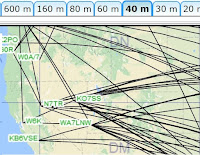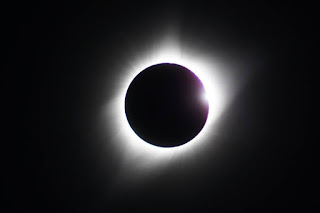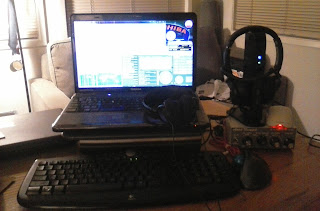It might surprise you
to know that I advocate cheating in radiosport.
In this context I define "cheating" as doing things that are NoT pro-hibited
by the rules, yet no one has thought to consider them before.
It is from this spirit that today we have spotting networks, Skimmers, SO2V and SO2R.
There was a time when many serious contesters considered these methods to be cheating;
or at the very least, operators using them were considered disingenuous.
For example, long before we had voice Keyers (like the MFJ Voice keyer or the WQ6X voice keyer software) many people solved the overdoing of one's voice problem by using various forms of tape recorders/players to call CQ and the like. As KX6H in Redondo Beach, I remember using a cassette recorder to make use of a 5-second telephone answering machine OGM tape to call CQ.
Long before there was readily available contest logging software (such as CT, and now N1MM+, WINTEST & WriteLog) a handful of contesters (such as myself) wrote their own custom software.
I once operated an All Asian CW contest from my 2nd floor cubicle at Data General's Western Education center in Manhattan Beach, Ca.
Thanks to the rooftop being 6 stories high I stealthily setup an 8JK flattop yagi barely a foot above the rooftop, orienting it N/W & S/E to broadside into Asia and the Atlantic Ocean on the back end.
With the operating QTH less than a mile from the beach, this antenna turned the ICOM 740's 103 watts into +5 db. punch giving the KX6H callsign (my call at the time) recognition into Asia.
It's not completely automated, however. Even in today's contest operations the operator must still type (or click for RTTY) the data into the entry boxes. However, the computer gives us immediate feedback when we've made a mistake.
Fortunately, as it turns out, the use of computers in radiosport occurred because a bunch of operators around the world had enough foresight to use them. Today, most serious contest operators would CRINGE at the thought of hand logging a contest. Consider also that because most radiosport GiGs encourage improvement in operating efficiency, use of computers contributes to improved emergency preparedness.
Being innovative can easily make its way into SSB operations. Recently several SSB contests have inspired
me to include playback of the EASY Button during the
"Thank You" message that originates when function key
F3 is pressed, saying "Thank You! [That was EASY] - QRZ, WQ6X". In contests like JIDX and All Asian, most people don't "get" it so I don't use it.
Another idea that worked out I implemented several years ago putting together a Multi-OP ARRL 10-meter contest operation from W7AYT's QTH in Concord Ca. (altho at the time Dennis was not a licensed ham).
As a contest weekend rolls around,
I keep an eye on space WX conditions to get an idea what propagation may be like for that contest.
Websites like DXMaps give yet another look at possible propagation anomalies
I might encounter.
The trick is knowing what the data means and/or how to interpret it.
No matter what degree of technology you employ to make your radio operations work better, there is still
no substitute for a highly rehearsed, expertly trained operator.
When you engage in radiosport, do YOU Cheat (but within the rules)?
Tell me about your exploits.
Ron
WQ6X
or at the very least, operators using them were considered disingenuous.
For example, long before we had voice Keyers (like the MFJ Voice keyer or the WQ6X voice keyer software) many people solved the overdoing of one's voice problem by using various forms of tape recorders/players to call CQ and the like. As KX6H in Redondo Beach, I remember using a cassette recorder to make use of a 5-second telephone answering machine OGM tape to call CQ.
Long before there was readily available contest logging software (such as CT, and now N1MM+, WINTEST & WriteLog) a handful of contesters (such as myself) wrote their own custom software.
I once operated an All Asian CW contest from my 2nd floor cubicle at Data General's Western Education center in Manhattan Beach, Ca.
Thanks to the rooftop being 6 stories high I stealthily setup an 8JK flattop yagi barely a foot above the rooftop, orienting it N/W & S/E to broadside into Asia and the Atlantic Ocean on the back end.
With the operating QTH less than a mile from the beach, this antenna turned the ICOM 740's 103 watts into +5 db. punch giving the KX6H callsign (my call at the time) recognition into Asia.
Because All Asian is a 48-hour contest, after everyone in the office went home for the weekend,
I snuck in a sleeping bag to crash unobserved under my desk throughout the weekend.
In addition to the 6-story height advantage, a reason I wanted to operate from my office is that it would provide access to the DG MV/10000 computer network we maintained for student training purposes.
Altho running AOS/Vs on the MV/10000, I made a special backwards compatible installation of DG's eXtended Basic software development IDE under which
I snuck in a sleeping bag to crash unobserved under my desk throughout the weekend.
In addition to the 6-story height advantage, a reason I wanted to operate from my office is that it would provide access to the DG MV/10000 computer network we maintained for student training purposes.
Altho running AOS/Vs on the MV/10000, I made a special backwards compatible installation of DG's eXtended Basic software development IDE under which
I wrote prototype code for a never-released KX6H-Logger program.
While nothing like today's professionally designed software, that program could DUPE check
callsigns and complete entered QSO data with data from a previous QSO with that callsign. The software produced a .Contest file (essentially a cross between a .Text and a .INI file). While the file format was hardly as robust as the currently accepted CABRILLO format, being a .Text file it could be easily printed and snail-mailed (we didn't have e-mail back then).
When the word got out that many operators were making use of computers
to assist them in contesting, some people decried these users as in some way CHEATing.
Today, not only are logging programs ubiquitous, some programs are ALMOST
(I stress the word almost) capable of running
a contest without an operator in the chair.
Thanks to .WAV files and keyboard macros which can be auto-invoked, today's operator
can find free time in between CQ's to eat some bites of food or pop a brewski. Then, when a station calls in, the press of another function
key sends the needed information.
While nothing like today's professionally designed software, that program could DUPE check
callsigns and complete entered QSO data with data from a previous QSO with that callsign. The software produced a .Contest file (essentially a cross between a .Text and a .INI file). While the file format was hardly as robust as the currently accepted CABRILLO format, being a .Text file it could be easily printed and snail-mailed (we didn't have e-mail back then).
When the word got out that many operators were making use of computers
to assist them in contesting, some people decried these users as in some way CHEATing.
Today, not only are logging programs ubiquitous, some programs are ALMOST
(I stress the word almost) capable of running
a contest without an operator in the chair.
Thanks to .WAV files and keyboard macros which can be auto-invoked, today's operator
can find free time in between CQ's to eat some bites of food or pop a brewski. Then, when a station calls in, the press of another function
key sends the needed information.
It's not completely automated, however. Even in today's contest operations the operator must still type (or click for RTTY) the data into the entry boxes. However, the computer gives us immediate feedback when we've made a mistake.
Fortunately, as it turns out, the use of computers in radiosport occurred because a bunch of operators around the world had enough foresight to use them. Today, most serious contest operators would CRINGE at the thought of hand logging a contest. Consider also that because most radiosport GiGs encourage improvement in operating efficiency, use of computers contributes to improved emergency preparedness.
Being innovative can easily make its way into SSB operations. Recently several SSB contests have inspired
me to include playback of the EASY Button during the
"Thank You" message that originates when function key
F3 is pressed, saying "Thank You! [That was EASY] - QRZ, WQ6X". In contests like JIDX and All Asian, most people don't "get" it so I don't use it.
Another idea that worked out I implemented several years ago putting together a Multi-OP ARRL 10-meter contest operation from W7AYT's QTH in Concord Ca. (altho at the time Dennis was not a licensed ham).
Remember that in 2011 Solar Cycle 24 was on the way up (about 60% of its eventual peak).
At that time in the sunspot cycle, 10-meters opened relatively early in the morning and remained active until well after sunset, during the month of December (which is when the 10-meter contest
is run).
On Saturday in this contest, some friends came over to enjoy a Dennis-created meal. Not only did
I put Kathy & Brian behind the microphone, I wrote a script for each of the 4 voice keyer memories
in the ICOM-7000, having Kathy speak them into the radio. For the next 18 hours after she left, Kathy's voice ran the SSB part of the 10-meter contest while the N1MM CW macros ran the code
side of things.
Now, it all sounds easy; and it is - with LoTsa practice. Remember, YOU are still the control operator; you are the
one who must push the function keys
in the right order.
At that time in the sunspot cycle, 10-meters opened relatively early in the morning and remained active until well after sunset, during the month of December (which is when the 10-meter contest
is run).
On Saturday in this contest, some friends came over to enjoy a Dennis-created meal. Not only did
I put Kathy & Brian behind the microphone, I wrote a script for each of the 4 voice keyer memories
in the ICOM-7000, having Kathy speak them into the radio. For the next 18 hours after she left, Kathy's voice ran the SSB part of the 10-meter contest while the N1MM CW macros ran the code
side of things.
Now, it all sounds easy; and it is - with LoTsa practice. Remember, YOU are still the control operator; you are the
one who must push the function keys
in the right order.
You must correctly type information
you receive during each QSO.
you receive during each QSO.
If in the end, mistakes are made attributable to the use of a computer, then you neglected
to test-drive one of the most important contest tools today: the LOGGING Computer itself
Automation can be a good thing if properly configured and tested BEFOREHAND.
For example, the N1MM+ software which I use much of the time makes a weekly software
update available virtually every Wednesday or Thursday. The week of an upcoming contest
event, no later than Thursday, I fire-up N1MM+ on the computer I will be running it from and
wait for the "Update is Available...." message. After installing the update, I read the update file
to notice if the update might in some way be relevant to what I will be doing. Information is Power.
to test-drive one of the most important contest tools today: the LOGGING Computer itself
Automation can be a good thing if properly configured and tested BEFOREHAND.
For example, the N1MM+ software which I use much of the time makes a weekly software
update available virtually every Wednesday or Thursday. The week of an upcoming contest
event, no later than Thursday, I fire-up N1MM+ on the computer I will be running it from and
wait for the "Update is Available...." message. After installing the update, I read the update file
to notice if the update might in some way be relevant to what I will be doing. Information is Power.
As a contest weekend rolls around,
I keep an eye on space WX conditions to get an idea what propagation may be like for that contest.
Websites like DXMaps give yet another look at possible propagation anomalies
I might encounter.
The trick is knowing what the data means and/or how to interpret it.
No matter what degree of technology you employ to make your radio operations work better, there is still
no substitute for a highly rehearsed, expertly trained operator.
When you engage in radiosport, do YOU Cheat (but within the rules)?
Tell me about your exploits.
Ron
WQ6X
























































